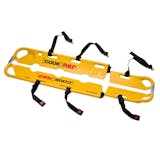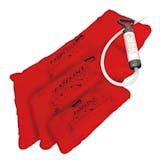Posterior Tibial Tendon Dysfunction (PTTD)
What is PTTD?
PTTD stands for Posterior Tibial Tendon Dysfunction. The posterior tibial tendon is located in the inside of the ankle and is used as one of the main supports of the foot and arch. PTTD occurs when this tendon becomes damaged and is no longer able to support the arch, resulting in a flattening of the foot. This is usually as a result of overuse injury in which excessive activity which uses the tendon is undergone, putting added pressure on the tendon which it is unable to withstand. This makes the injury common in sports such as running, hiking and gymnastics.
PTTDs are common sport-related injuries to the ligament and usually come as a result of a twisting or pivoting force to the knee or from a direct impact to the area. This is a very common injury in field sports such as football, rugby and hockey due to the tackling and collisions involved. PTTDs are also common in basketball and netball when the knee twists after landing hard from a jump.
The severity of an PTTD can vary from partial damage or tearing to a complete MCL rupture.
PTTD Symptoms
Patients who suffer PTTD often feel pain in the inside of the foot and ankle which is accelerated when running, jumping or hopping. The patient may notice that the arch has become flatter and that their ankle begins rolling inward. It is common for the area to feel weakened and unable to bear weight in activities and it is likely that the patient will feel stiffness in the area which is most apparent in mornings. As this injury tends to come as a result of over use, pain is likely to increase gradually over weeks or months which may cause the area of pain to change from the inside of the foot to the outside and the toes may begin to turn outwards.PTTD Diagnosis
In order to diagnose PTTD a doctor will give a full examination of the area and an MRI may be performed in order to confirm the diagnosis and to rule out any further injury or complications.PTTD Treatment
 In order to treat this injury, rest is crucial so to not damage the tendon any further and to stay away from any activity that could aggravate the knee or causes any pain or discomfort to the area. Continuing any strenuous activity or resuming sport will not only hinder the healing process, it could lead to further damage to the tendon and surrounding tissue.
Applying ice to the area is also an important aspect of recovery for any tendon injury as it will minimise any swelling and inflammation of the area. Following the PRICE method (Protection, Rest, Ice, Compression, Elevation) when the injury first occurs and within the following 72 hours will ensure no further damage is caused to the area and prevent any further swelling of the injury which may come from resuming activity. Anti-Inflammatory medications may be taken to relive the pain of the injury and also to minimise any swelling.
An ankle brace may be recommended in order to give the area plenty of support, and in more severe cases complete immobilisation may be required and therefore a plaster cast may be given. A strengthening program may also be advised by a physiotherapist to keep the area strong and ensure flexibility once the injury had healed. This should not be done without professional advice as a patient can run the risk of aggravating the area and slow the healing process. In the final stages of recovery and in the first few months of returning to training, stretching exercises to the quadriceps, hamstring and calf muscles may be performed to keep the area stable and strong and can also help prevent the injury reoccurring.
Arch supports are useful for patients who are prone to this injury as they will offer further support to the arch of the foot which can be used when healing or for more chronic cases whenever activity involving a lot of walking or running is undergone.
In order to treat this injury, rest is crucial so to not damage the tendon any further and to stay away from any activity that could aggravate the knee or causes any pain or discomfort to the area. Continuing any strenuous activity or resuming sport will not only hinder the healing process, it could lead to further damage to the tendon and surrounding tissue.
Applying ice to the area is also an important aspect of recovery for any tendon injury as it will minimise any swelling and inflammation of the area. Following the PRICE method (Protection, Rest, Ice, Compression, Elevation) when the injury first occurs and within the following 72 hours will ensure no further damage is caused to the area and prevent any further swelling of the injury which may come from resuming activity. Anti-Inflammatory medications may be taken to relive the pain of the injury and also to minimise any swelling.
An ankle brace may be recommended in order to give the area plenty of support, and in more severe cases complete immobilisation may be required and therefore a plaster cast may be given. A strengthening program may also be advised by a physiotherapist to keep the area strong and ensure flexibility once the injury had healed. This should not be done without professional advice as a patient can run the risk of aggravating the area and slow the healing process. In the final stages of recovery and in the first few months of returning to training, stretching exercises to the quadriceps, hamstring and calf muscles may be performed to keep the area stable and strong and can also help prevent the injury reoccurring.
Arch supports are useful for patients who are prone to this injury as they will offer further support to the arch of the foot which can be used when healing or for more chronic cases whenever activity involving a lot of walking or running is undergone.





















